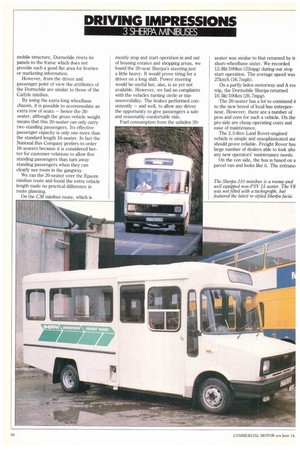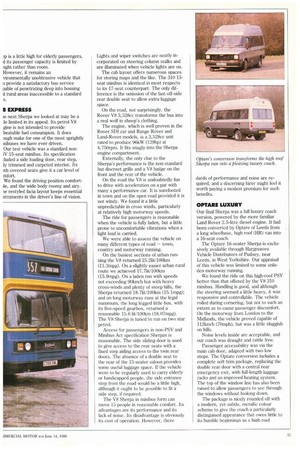DRIVING IMPRESSIONS SF - ERPA MINIBUSES
Page 50

Page 51

If you've noticed an error in this article please click here to report it so we can fix it.
mobile structure, Dormobile rivets its panels to the frame which does not provide such a good flat area for liveries or marketing information.
However, from the driver and passenger point of view the attributes of the Dormobile are similar to those of the Carlyle minibus.
By using the extra long wheelbase chassis, it is possible to accommodate an extra row of seats — hence the 20seater, although the gross vehicle weight means that this 20-seater can only carry two standing passengers. Its effective passenger capacity is only one more than the standard length 16-seater. In fact the National Bus Company prefers to order 16-seaters because it is considered better for customer relations to allow five standing passengers than turn away standing passengers when they can clearly see room in the gangway.
We ran the 20-seater over the Epsom minibus route and found the extra vehicle length made no practical difference in route planning.
On the CM minibus route, which is mostly stop and start operation in and out of housing estates and shopping areas, we found the 20-seat Sherpa's steering just a little heavy. It would prove tiring for a driver on a long shift. Power steering would be useful but, alas, is as yet not available. However, we had no complaints with the vehicles turning circle or manoeuvrability. The brakes performed consistently — and well, to allow any driver the opportunity to give passengers a safe and reasonably comfortable ride.
Fuel consumption from the unladen 20 seater was similar to that returned by it: short-wheelbase sister. We recorded 12.81it/100km (22mpg) during our stop start operation. The average speed was 27km/h (16.7mph).
On a partly laden motorway and A roa trip, the Dormobile Sherpa returned 10.51it/1001an (26.7mpg).
The 20-seater has a lot to commend ii to the new breed of local bus entrepreneur. However, there are a number of pros and cons for such a vehicle. On the pro side are cheap operating costs and ease of maintenance.
The 2.5-litre Land Rover-engined vehicle is simple and unsophisticated anc should prove reliable. Freight Rover has large number of dealers able to look afte any new operators' maintenance needs.
On the con side, the bus is based on a parcel van and looks like it. The entranc4 ep is a little high for elderly passengers, d its passenger capacity is limited by eight rather than room.
However, it remains an vironmentally unobtrusive vehicle that n provide a satisfactory bus service pable of penetrating deep into housing d rural areas inaccessible to a standard S.
EXPRESS le next Sherpa we looked at may be a :le limited in its appeal. Its petrol V8 One is not intended to provide beatable fuel consumpion. It does ough make for one of the most sprightly nibuses we have ever driven.
Our test vehicle was a standard non;‘,/ 15-seat minibus. Its specification :luded a side loading door, rear step, Lly trimmed and carpeted interior. Its )th covered seats give it a car level of rnfort.
We found the driving position comfortIle, and the wide body roomy and airy. le restyled facia layout keeps essential struments in the driver's line of vision. Lights and wiper switches are neatly incorporated on steering column stalks and are illuminated when vehicle lights are on.
The cab layout offers numerous spaces for storing maps and the like. The 310 15seat minibus is identical in most respects to its 17-seat counterpart. The only difference is the omission of the last off-side rear double seat to allow extra luggage space.
On the road, not surprisingly, the Rover V8 3, 52&c transforms the bus into a real wolf in sheep's clothing.
The engine, which is well proven in the Rover SDI car and Range Rover and Land-Rover models, is a 3,528cc unit rated to produce 96kW (129hp) at 4,750rpm. It fits snugly into the Sherpa engine compartment.
Externally, the only clue to the Sherpa's performance is the non-standard but discreet grille and a V8 badge on the front and the rear of the vehicle.
On the road the V8 is undoubtedly fun to drive with acceleration on a par with many a performance car. It is surefooted in town and on the open road provided it is not windy. We found it a little unpredictable in cross winds, particularly at relatively high motorway speeds.
The ride for passengers is reasonable when the vehicle is fully laden, but a little prone to uncomfortable vibrations when a light load is carried.
We were able to assess the vehicle on many different types of road — town, country and motorway running.
On the busiest sections of urban running the V8 returned 25.21it/100km (11.2mpg). On a slightly easier urban rural route we achieved 17.711t/100km (15.9mpg). On a laden run with speeds not exceeding 90km/h but with heavy cross-winds and plenty of steep hills, the Sherpa returned 18.71R/100km (15.1mpg); and on long motorway runs at the legal maximum, the long legged little bus, with its five-speed gearbox, returned a reasonable 15.6 lit/1001un (18.07mpg). The VS Sherpa is tuned to run on two star petrol.
Access for passengers in non-PSV and Minibus Act specification Sherpas is reasonable. The side sliding door is used to give access to the rear seats with a fixed step aiding access to the twin rear doors. The absence of a double seat to the rear of the 15-seater saloon provides some useful luggage space. If the vehicle were to be regularly used to carry elderly or handicapped people, the side entrance step from the road would be a little high, although it ought to be possible to fit a side step, if required.
The V8 Sherpa in minibus form can move 15 people in reasonable comfort. Its advantages are its performance and its lack of noise. Its disadvantage is obviously its cost of operation. However, there dards of performance and noise are required, and a discerning hirer might feel it worth paying a modest premium for such benefits.
OPTARE LUXURY Our final Sherpa was a full luxury coach version, powered by the more familiar Land Rover 2.5-litre diesel engine. It had been converted by Optare of Leeds from a long wheelbase, high roof (HR) van into a 16-seat coach.
The Optare 16-seater Sherpa is exclusively available through Hargreaves Vehicle Distributors of Pudsey, near Leeds, in West Yorkshire. Our appraisal of this vehicle was limited to some unladen motorway running.
We found the ride on this high-roof PSV better than that offered by the V8 310 minibus. Handling is good, and although the steering seemed a little heavy, it was responsive and controllable. The vehicle rolled during cornering, but not to such an extent as to cause passenger discomfort. On the motorway from London to the Midlands, the vehicle proved capable of 112km/h (70mph), but was a little sluggish on hills.
Noise levels inside are acceptable, and our coach was draught and rattle free.
Passenger accessibility was via the main cab door, adapted with two low steps, The Optare conversion includes a complete soft trim package, replacing the double rear door with a central rear emergency exit, with full-length luggage racks and an improved heating system. The top of the window line has also been raised to allow passengers to see through the windows without looking down.
The package is nicely rounded off with a modern, yet subtle, metallic colour scheme to give the coach a particularly distinguised appearance that owes little to its humble beginnings as a high-roof




























































